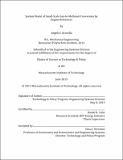System model of small-scale gas-to-methanol conversion by engine reformers
Author(s)
Acocella, Angela J. (Angela Josephine)
DownloadFull printable version (5.781Mb)
Other Contributors
Massachusetts Institute of Technology. Technology and Policy Program.
Advisor
Daniel R. Cohn.
Terms of use
Metadata
Show full item recordAbstract
As global energy demands grow and environmental concerns over resource extraction methods intensify, high impact solutions are becoming increasingly essential. Venting and flaring of associated natural gas represents significant environmental and financial losses yet it continues in the North Dakota Bakken oil play. The valuable gas resource is wasted due to unfavorable economics and limited pipeline capacity. Similarly in India, underdeveloped gas transport infrastructure and restrictive regulatory frameworks prevent distribution and marketing of natural gas from the northeast regions, leaving it stranded in marginal fields. This thesis establishes a techno-economic model, utilizing Aspen Plus chemical processing software, and a discounted cash flow model to estimate economic feasibility of implementing MIT engine reformer-based gas-to-liquids (GTL) systems in the US or India. The system reforms natural gas via partial oxidation into synthesis gas (syngas) in the cylinders of an internal combustion engine, and can significantly reduce capital costs over conventional GTL reforming processes. The engine is operated in fuel rich conditions to generate the syngas, which is synthesized into methanol and dimethyl ether (DME). Once produced on-site, these liquids are more easily transported than gases. This study assesses the regulatory structures surrounding the upstream methane resource and downstream end product marketability for three scenarios: use of DME to replace existing local (1) diesel and (2) liquefied petroleum gas (LPG), or (3) sale of methanol as a commodity chemical on domestic or global markets. The analysis shows the system is economical in both locations. In the US, the minimum economically efficient production capacity with a 1-2 year payback period is 400,000- 860,000 standard cubic feet per day (scfpd) of natural gas for the range of end use scenarios considered. Differences in costs and product market characteristics in India result in a minimum efficient capacity of 330,000-810,000 scfpd of natural gas for the three scenarios.
Description
Thesis: S.M. in Technology and Policy, Massachusetts Institute of Technology, Engineering Systems Division, 2015. This electronic version was submitted by the student author. The certified thesis is available in the Institute Archives and Special Collections. Cataloged from student-submitted PDF version of thesis. Includes bibliographical references (pages 88-93).
Date issued
2015Department
Massachusetts Institute of Technology. Engineering Systems DivisionPublisher
Massachusetts Institute of Technology
Keywords
Engineering Systems Division., Technology and Policy Program.